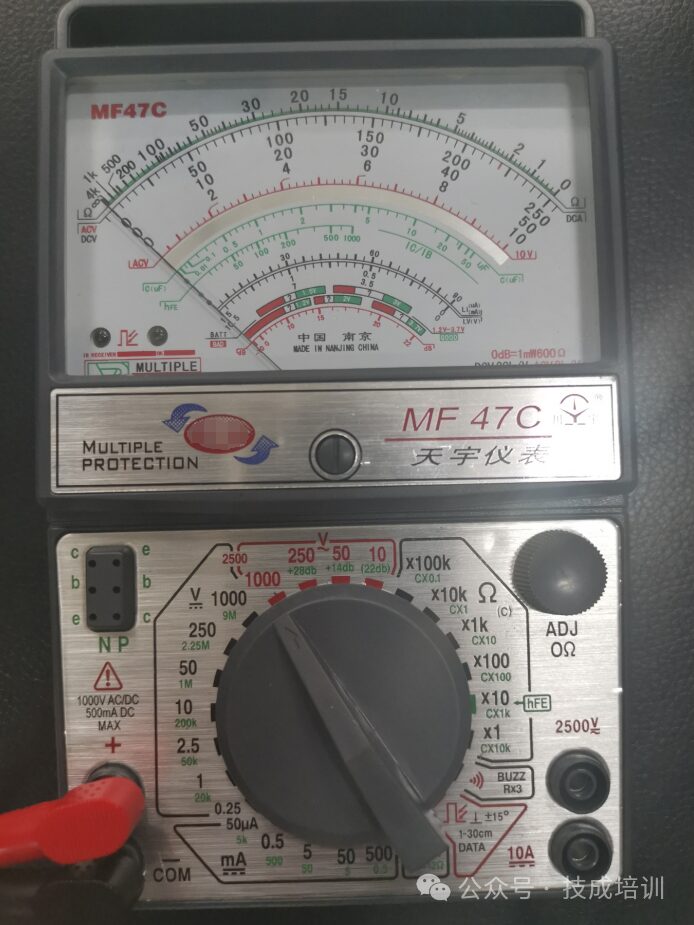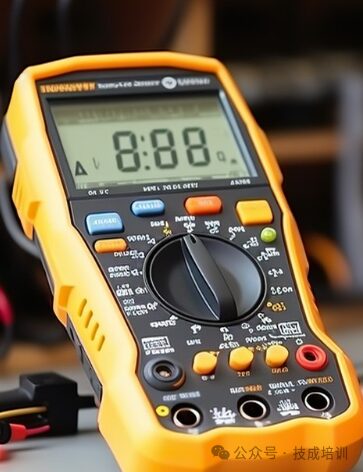

1. The multimeter is divided into analog and digital multimeters.
As shown in the figure below, the left image is an analog multimeter, and the right image is a digital multimeter.




2. The function of the multimeter is to measure AC voltage, DC voltage, DC current, resistance, and other multifunctional instruments.


3. Inspection before using the multimeter.
(1) Appearance inspection: the appearance should be intact and undamaged. When gently shaken, the pointer should move freely, and the selector switch should switch flexibly, the indicated range should be accurate.
(2) Mechanical zero adjustment: Place the instrument flat, and the pointer should point to the zero voltage or zero current position. If it is not at the 0 position, adjust the mechanical zero adjustment knob to the zero position.
(3) Ohm zero adjustment: Set the range switch to the ohm range, short-circuit the two probes, and adjust the ohm zero adjustment knob so that the pointer aligns with the first scale line at 0 position.
(4) Check if the probe connections are correct, with the red probe connected to the positive terminal and the black probe connected to the negative terminal.
(5) Check if the range rotation is flexible and if the contact is good.
4. Measurement of AC and DC voltage.
When measuring voltage, the probes must be connected in parallel to the circuit being measured; otherwise, the meter may burn out. When measuring DC voltage, pay attention to the polarity of the voltage being measured: connect the red probe to the positive terminal and the black probe to the negative terminal.
When measuring voltages below 1000V, select the required DC voltage range or AC voltage range (be careful to distinguish between AC and DC), connect the red probe to the ” + ” terminal, and read the value on the second circle of the dial, calculating the scale value according to the range.
When measuring voltages between 1000V and 2500V, select the 1000V DC voltage range or 1000V AC voltage range, and connect the red probe to the “2500V” terminal.
Use the correct range and scale. The reading should be taken when the pointer is deflected to a larger position to improve measurement accuracy.
When measuring high voltage, do not change the range while measuring. If a range change is needed, disconnect the probes first, change the range, and then measure; otherwise, it may damage the multimeter.
5. Measuring resistance.
(1) Set the selector switch to the “Ω” range, using the Rx100 range for rough measurement.
(2) Ohm zero adjustment: short-circuit the two probes, and the pointer should point to the zero position. If it is not at the zero position, adjust the ohm zero to the zero position.
(3) Connect the resistance to be measured between the two probes and read the value of one scale line.
a. If the pointer is near “0” (indicating a very small reading), adjust the selector switch to a lower range.
b. If the pointer is near the middle, an accurate reading can be taken: the resistance value = reading value X range multiplier + unit “Ω”
c. Each time a range is changed, the ohm zero adjustment must be performed; zero adjustment must be done when changing ranges.
(4) After use, set the selector switch to OFF or the highest AC voltage range.
Article source: Original from Jicheng Training Network, Author: Meng Weiping; Unauthorized reproduction is prohibited, and violators will be prosecuted!
Complete question bank for the 2022 Electrician Junior Exam (including answers)
3 essential tools for electrical workers, accessible with one click on WeChat!
[Collect] The “way out” for a ten-year experienced electrician, the secret to earning over ten thousand a month!
Which of the five major electrical drawing software (CAD, Eplan, CADe_simu…) do you pick?
Latest electrical CAD drawing software, with super detailed installation tutorial!
Latest electrical drawing software EPLAN, with super detailed installation tutorial!
Common problems for beginners using S7-200 SMART programming software (with download link)
Comprehensive electrical calculation EXCEL spreadsheets, generated automatically! No need to seek help for electrical calculations!
Bluetooth headsets, introductory books for electricians/PLC available for free? Come and claim your electrical gifts!
Basic skills for PLC programming: ladder diagrams and control circuits (with 1164 practical cases of Mitsubishi PLC)
Still can’t understand electrical diagrams? Basic electrical diagram reading skills, simulation software available for quick hands-on practice!
12 free electrician video courses, 10GB of software/e-book materials, and 30 days of free electrician live classes are available!
